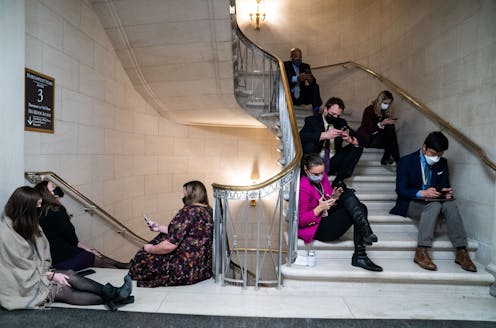Congress is waiting on the CBO for its Build Back Better report – but how did fiscal scorekeepers come to be so powerful in politics?
- Written by Philip Rocco, Assistant Professor of Political Science, Marquette University

“How much will it cost?” This question, perhaps more than any other, bedevils Congress’ efforts to change public policy. And whatever problems a major piece of legislation might purport to solve, no adjective grabs more headlines than the price tag.
This is certainly the case in the current debate over President Joe Biden’s proposed Build Back Better[1] legislation, which rarely makes the news without mention of its estimated US$1.75 trillion cost[2].
There is one overriding reason for this: the Congressional Budget Office[3], known popularly as the CBO. The CBO is tasked with “scoring” legislation by estimating the impact that it would have on both revenue and spending. But as a scholar who investigates CBO score controversies[4], I know that the office’s figures are often used for partisan reasons.
While Congress has always debated how much government initiatives should cost, the creation of the CBO almost five decades ago[5] and the canonization of its cost estimates have helped make the “price tag” – a term rarely used to describe acts of Congress until the 1980s – one of the most prominent and visible aspects of lawmaking.
In the case of Build Back Better, five House Democrats have refused to take a vote on the social spending bill[6] until the CBO provides a full cost estimate for the measure, which it has pledged to do by Nov. 19[7].
There is no legal requirement for House members to have these scores prior to the vote, unlike in the Senate[8]. Yet for fiscal hawks, these cost figures have been the key negotiating point in the progress of the Build Back Better legislation.
But why does the Congressional Budget Office exist? And what gives this agency with fewer than 300 employees such power over American political life?
The rise of the cost analysts
The CBO was born in 1974[9] and was designed to be an independent source of analysis for Congress, especially in the context of an increasingly powerful executive branch.
Following controversies over President Richard Nixon’s impoundment[10] – that is, refusal to release funds – for projects he opposed, congressional leaders attempted to design an agency that would counterbalance the power of the president in the budgetary process. While the CBO’s director is chosen every four years by the Speaker of the House and the president pro tempore of the Senate, the office was designed to be nonpartisan and loyal above all to Congress, capable of checking the assumptions of the White House’s Office of Management and Budget[11] as well as other executive-branch institutions.
But the CBO’s current reputation as the neutral arbiter of the federal budget was hardly foreordained. In the early years, the CBO’s numbers frequently came in for criticism, specifically when it contradicted the Reagan administration’s argument[12] that a massive tax cut would lead to a budget surplus.
During the first decade of the CBO’s existence, Congress frequently slashed the office’s budget, creating a half-dozen “near-death experiences,” in the words of former director[13] Robert Reischauer.
But, as my research suggests[14], it survived for two main reasons. First, the House and Senate budget committees – created around the same time[15] as the CBO – relied on the office for useful information that could leverage their positions in the policymaking process. They also defended it from its attackers in the Reagan administration and, later, protected it from then House Speaker Newt Gingrich-led efforts to bleed[16] Congress of independent legislative support.
During the 1980s, Democrats increasingly came to value the CBO as a tool for critiquing the effects of the Reagan administration’s policies on the federal budget deficit. The 1984 Democratic platform mentioned the deficit over 40 times[17].
But the strongest defense of the CBO came from lawmakers’ and reporters’ increasing preoccupation with the federal budget deficit, or the annual difference between federal spending and revenue. While the CBO continued to face cuts throughout the 1980s, mounting pressure to address the deficit pressures gave the office a window to influence the policy process in a new way. As former director Rudy Penner recalled[18], while the CBO could not take policy positions, he felt it was “safe for me to be against deficits.”
Mentions of the CBO in the press, my research suggests[19], hinge in large part on the size of the federal budget deficit.
By the early 1990s, congressional efforts to set automatic deficit reduction targets[20] made CBO’s scores a central standard by which new policy ideas are evaluated. Following Congress’s creation of Pay-As-You-Go[21] (PAYGO) requirements in the early 1990s – designed to enforce deficit reduction targets – legislators began to seek out unofficial estimates of program costs from the CBO.
As Reischauer recalls, PAYGO had an almost “psychological” effect[22] on members of Congress. Republicans used the CBO’s scores to attack[23] President Bill Clinton’s national health reform proposal. Democrats attacked Republican tax cuts by citing projections by the CBO of their deficit effects[24]. Members would soon begin shelving or heavily revising costly proposals so as not to, in Reischauer’s words[25], “screw up the PAYGO scorecard.”
Who scores governs
By the end of the 1990s, the CBO was not merely a source of policy expertise for Congress. The office’s budget projections also helped determine political reality.
“CBO is God around here,” as Republican Senator Chuck Grassley once put it[26], “because policy lives and dies by CBO’s word.”
Assumptions embedded in CBO reports cannot always be easily questioned. Congress exempted the budget office, as it had other legislative service agencies, from the Freedom of Information Act[27], meaning that the public could only access a limited range of the budget office’s analytical inputs.
[More than 140,000 readers get one of our informative newsletters. Join the list today[28].]
The CBO’s scorekeeping rules can also arbitrarily constrain what goes into the score itself. For example, while Biden’s Build Back Better package proposes to generate $400 billion in additional revenue through enhanced IRS enforcement, scoring rules deem these revenues “not scoreable[29].” Similarly, CBO’s 10-year scoring window makes the cost of climate change[30] policies highly visible, but essentially erases evidence of their long-term benefits.
Scorekeeping is what Congress makes of it
In recent years, Democratic congressional leaders have seemingly become overly reliant on CBO scores as a metric for judging legislation.
In the first few months of the COVID-19 pandemic, House Speaker Nancy Pelosi rejected including provisions in relief legislation that would have tied benefit levels to the duration of the crisis. Her reasoning was that the CBO’s scorekeeping rules for such a measure inflated the total price tag[31] for the legislation beyond Pelosi’s proposed $3 trillion ceiling.
Republicans, on the other hand, have appeared more likely to dismiss bad numbers out of hand. When the CBO’s initial score showed significant deficit effects of their 2017 tax cuts, and when the Joint Committee on Taxation’s “dynamic” analysis – which took into account the effects of tax cuts on economic growth – didn’t look much better, Republicans simply argued[32] that the scores weren’t sufficiently dynamic, and passed the legislation anyway.
While CBO and fiscal scorekeeping are powerful veto points in American politics, they are ultimately creatures of Congress. That means congressional coalitions can alter them, or simply ignore them, when they believe it is wise – or politically necessary – to do so.
References
- ^ Build Back Better (budget.house.gov)
- ^ estimated US$1.75 trillion cost (nypost.com)
- ^ Congressional Budget Office (www.cbo.gov)
- ^ scholar who investigates CBO score controversies (www.marquette.edu)
- ^ almost five decades ago (theconversation.com)
- ^ refused to take a vote on the social spending bill (www.usnews.com)
- ^ pledged to do by Nov. 19 (thehill.com)
- ^ Senate (www.everycrsreport.com)
- ^ born in 1974 (www.cbo.gov)
- ^ President Richard Nixon’s impoundment (www.politico.com)
- ^ Office of Management and Budget (www.whitehouse.gov)
- ^ contradicted the Reagan administration’s argument (www.cbo.gov)
- ^ in the words of former director (digitalassets.lib.berkeley.edu)
- ^ as my research suggests (doi.org)
- ^ created around the same time (www.senate.gov)
- ^ to bleed (washingtonmonthly.com)
- ^ mentioned the deficit over 40 times (www.presidency.ucsb.edu)
- ^ former director Rudy Penner recalled (digitalassets.lib.berkeley.edu)
- ^ my research suggests (doi.org)
- ^ automatic deficit reduction targets (bancroft.berkeley.edu)
- ^ Congress’s creation of Pay-As-You-Go (www.cbpp.org)
- ^ an almost “psychological” effect (doi.org)
- ^ used the CBO’s scores to attack (www.tampabay.com)
- ^ their deficit effects (www.nbcnews.com)
- ^ Reischauer’s words (digitalassets.lib.berkeley.edu)
- ^ once put it (www.finance.senate.gov)
- ^ Freedom of Information Act (crsreports.congress.gov)
- ^ Join the list today (memberservices.theconversation.com)
- ^ not scoreable (www.bloomberg.com)
- ^ climate change (www.eenews.net)
- ^ price tag (www.businessinsider.com)
- ^ argued (www.nytimes.com)

















